|
|
#1
|
||||
|
||||
|
I realize that there is currently a discussion about this, but I didn't want to highjack the thread.
I for one am a PSA guy. I have nothing against SGC, but being a post-war collector, I choose PSA because it is more readily available. When it comes to Pre-War cards I am indifferent. I would like to limit this discussion to the T206 set. It seems as though PSA demands a higher price for mid grade and high grade cards. I went through VCP and took the average price of all T206 cards (minus the big 4) per grading company. What I found wasn't too surprising. PSA and SGC have an immaterial difference in their average price for low grade cards (ie. "2" & "3"). We start to see a difference at a "4" (With PSA at $132.66 compared to SGC at $124.48). NOTE: These prices include stars and Hall of Famers. This isn't a huge gap, but when we reach "5" the difference grows to $30 per card and at "6" the difference is over $60. See chart below: 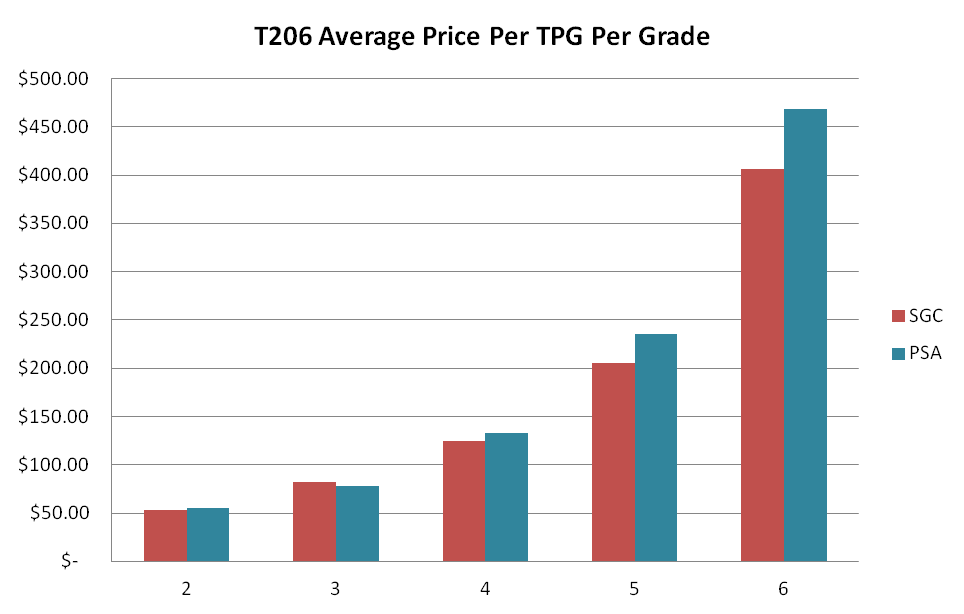 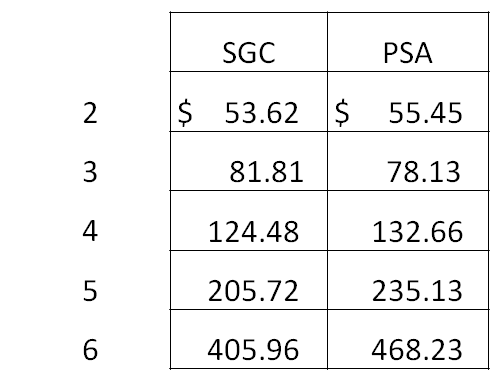 What explains this difference? At first I thought it was demand. Perhaps a higher concentration of mid grade SGC cards dilute their value. So, I then turned to the population reports of both companies. I was somewhat surprised at what I found. There are FAR more mid grade PSA T206 cards than SGC. Almost 25,000 more 4's, 15,000 more 5's, SIX times as many 6's and 5 times as many 7's. This anomaly is not explained by shear volume. A breakdown of the percentages show that PSA assigns a "4" to 27.28% of their cards while SGC is at a meager 18.06%, and SGC assigns a large amount of 1's and 2's. NOTE: For this analysis half grades were rounded down and qualifiers were given a 2 point deduction. 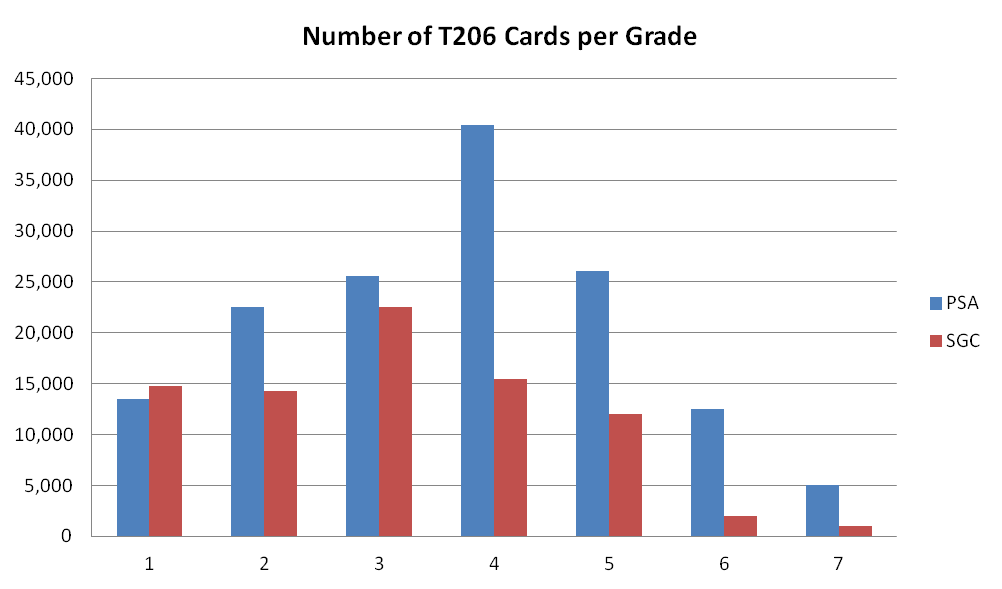 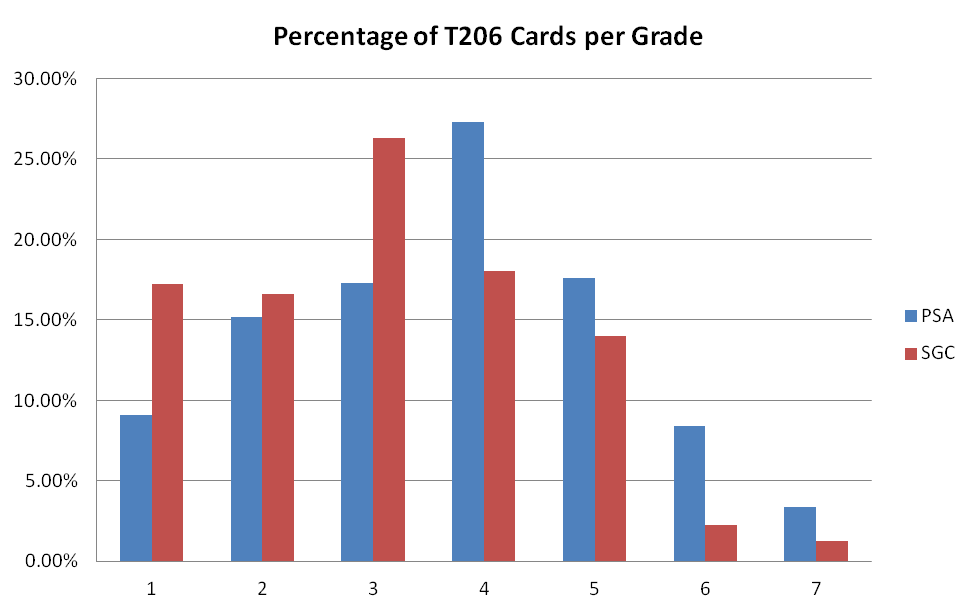 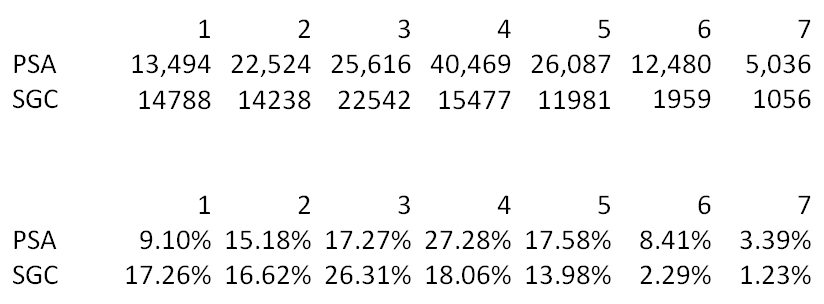 It seems as though mid grade T206 cards defy the most basic law of economics, supply and demand. There is a far greater supply of mid grade PSA cards as opposed to SGC, so why the difference in price? Well, SGC and PSA cater to two separate consumers. SGC, the collector; PSA, the investor. Most here can agree that SGC displays a card better than PSA. For a collector with no intention of selling their collection and only assigns a value based on a personal level, SGC is a far greater company to send your cards. To the collector who plans to sell their collection, PSA is the way to go. Neither one can fully understand the other and while I would label myself as an "investor" I have nothing but the utmost respect for collectors of SGC cards. I have a completed PSA registry set (not T206), and I while I enjoyed the rush of collecting the cards, I must admit I began to focus more on the plastic than the cardboard. It seems as though the "collector" who is obsessed with a numeric grade leans towards PSA. I'm not saying collectors of SGC cards do not care about condition, but they focus more on the card than the flip. This trend can be seen throughout all sets, but it is most obvious in this example. Neither the collector or the investor are better in anyway, they're just different and in conclusion; PSA and SGC are two very different companies that share the same market. While on the surface they appear identical, to an experienced collector, they are not. In my opinion it is pointless to argue which company is "better" or "worse" because quite simply, they are designed for different types of collectors. On a completely separate note I thought this was interesting: The total cost of assembling a graded T206 set (minus the big four). 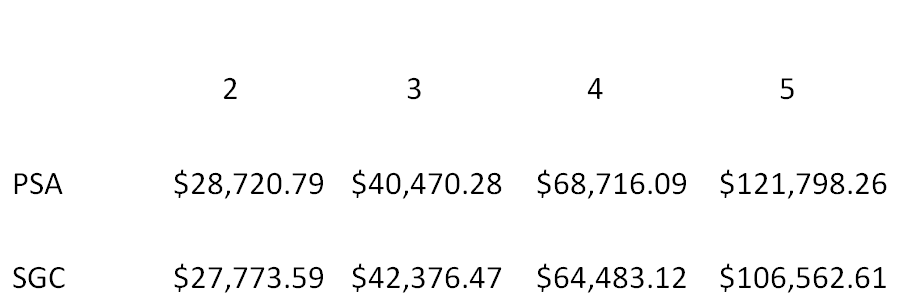
|
|
#2
|
||||
|
||||
|
Finally, some cold, hard facts! I was getting sick of people comparing all their anecdotal evidence. Looks like some solid work there.
Although I disagree that SGC slabs look better than PSA's. I like the minimalist, thin, transparent holders. I think they put more emphasis on the card rather than the case. But then again, that's all subjective 
|
|
#3
|
||||
|
||||
|
Wow, that is really cool.
Personally, I do not care about the grades, whatsoever. Not anymore. However, I absolutely love the black casing used by SGC. To me, it just looks cooler. I do hate, hate, hate the "unknown backs" in the PSA pop reports, but oh well... Really cool work in the OP. Thanks. Derek |
|
#4
|
|||
|
|||
|
Very interesting research. Thanks for sharing Jason. From all of the discussions on the board, I thought PSA was the best way to maximize your value for vintage cards (42-79) and SGC for pre-war.
Maybe the size of the holder plays a factor? I would imagine 500+ PSA cards take up significantly less room than 500+ SGC cards. |
|
#5
|
||||
|
||||
|
Great report. I do like the SGC holders. The cards present much nicer then PSA. However PSA does bring higher $$$
__________________
Ruben |
|
#6
|
||||
|
||||
|
Great work Jason with the stats.
I just wanted to say that there are many sales(private transactions) that don't get recorded on VCP. And then you have the crossovers that don't get recorded. So, there's probably a little wiggle room on there in either direction with population & prices realized. But I think you've given the most accurate breakdown that someone could possibly give- nice job !! I buy cards graded by both companies (well, all three including BVG) and I don't think much about resale value because I don't plan on selling any of mine until decades from now (knock on wood) and who knows where things will be then. I do know one thing- the cards will be that much older  . .Thanks for the breakdown, this was a cool read !! Sincerely, Clayton |
|
#7
|
|||
|
|||
|
PSA has more "supply", so more cards hit auction, more cards hit sales, more cards hit BIN's. If there wasn't a 1:2.67 ratio of PSA mid grade to SGC do you think they would demand more?
How many of these deviate higher or lower in price for each grade? The sheer volume difference IMO makes this simply an average of prices and not a reflection of the current market... Many more factors would need to be involved for a market value. The numbers being used can't be absolute because there is no way to know someone is going to pay exactly $23xxx or 64xxx for a set in whatever grade Last edited by Sean1125; 02-17-2013 at 07:06 AM. |
|
#8
|
|||
|
|||
|
Jason,
Useful information--thank you. Please consider expanding your post into an article and publishing. Scot |
|
#9
|
|||
|
|||
|
Quote:
Next, I disagree with your assertion that SGC caters only to collectors and PSA caters only to investors. No data has been provided that would even remotely support such a claim. Lastly- I agree with your comment about this defying the laws of supply and demand. What explains that outcome? People who begin the T206 set recognize and appreciate the higher availability of PSA cards in mid-grade, as they begin their set quest.The increased availability of mid grade T206, for that reason, has IMPROVED the cards value, not detracted from the value, as would be the case if we were talking about commodities. |
|
#10
|
||||
|
||||
|
If all the cards were of equal value theoretically, lumping all the grades and cards together would have more statistical validity.
This is a nice overview and interesting, but may be flawed from a pure statistical point of view. Without getting into p values and questioning the percentage of and which hall of famers are in each group, incorrect conclusions could be inferred from the numbers. In other words there could be some apples and oranges issues contained within the data presented. For example, if the higher valued cards are more likely to have been graded by PSA, then comparing average card prices by grade between SGC and PSA could be due to either higher prices for one company's slabs for the same card or a different distribution of cards within the subset and not a real difference in price for the same card. In no way should this be interpreted as criticism of the work in terms of accuracy, but merely a caution to members in terms of drawing too many conclusions from the data presented. I would add that I am not a statistician capable of validating presentations of this type, but merely a math guy who knows that numbers can be manipulated to validate assumed conclusions.
__________________
RAUCOUS SPORTS CARD FORUM MEMBER AND MONSTER FATHER. GOOD FOR THE HOBBY AND THE FORUM WITH A VAULT IN AN UNDISCLOSED LOCATION FILLED WITH WORTHLESS NON-FUNGIBLES 274/1000 Monster Number |
|
#11
|
||||
|
||||
|
Thanks for the informative post, OP. It was interesting to see what it would cost to put together a T-206 set minus the Big Four in various grades.
|
|
#12
|
||||
|
||||
|
+1 thank you for the work and for sharing it. I think any sampling of this scale will probably have some holes here or there, but it was really interesting and informative to look over your data. I'm about 50/50 between PSA and SGC, but don't generally care which holder it comes in.
|
|
#13
|
||||
|
||||
|
Quote:
Funny i was thinking the same thing about SGC...I HATE how they don't differentiate the variations of a certain card....for instance, they don't differentiate the e90-1 variations of keeler, which there are 3.....this happens throughoutnthenentire set which make you extrapolate the true pop... |
|
#14
|
||||
|
||||
|
Very cool post. I would definately like to read a more researched article. If you are interested in writing one let me know.
|
|
#15
|
|||
|
|||
|
Nothing against the OPs efforts a neat read. However I think you will find buying the entire T206 set minus the big four in EX condition from either company for 100-120k something that you would be hard pressed to do. Regardless if you buy it finished or card by card I think you will find that an all EX set will be much, much more. In fact if anyone has an all EX set minus the big 4 I will gladly pay the above prices.
|
|
#16
|
||||
|
||||
|
Quote:

|
|
#17
|
|||
|
|||
|
No shot at you Eddie just more of warning to not pull that IRA money too soon for this EX set for 100k. Know the feeling on prices you could offer certain cards for 75% off and I still couldnt afford them.

|
|
#18
|
||||
|
||||
|
Hey guys,
I wanted to further explore the subject and work with the data a bit more. What I found was pretty interesting. I agree with a lot of the feedback. It's unrealistic to group "commons" with "stars" to arrive at an average price. I decided to split the two and look at their numbers separately. First, I had to decide what constituted a "star" from a statistical stand point - I figured the easiest way would be by taking the 50 most expensive cards out, and designating the remaining as "commons". NOTE: While some might argue against this approach it actually was an effective way of keeping the hard to find commons while filtering out the lower dollar Hall of Famers. Now, just for the sake of it, here are the 50 most expensive T206 cards in PSA 4 (I chose this measure because it contained the most data from VCP). These are the cards I consider "stars" for the purpose of this discussion: NOTE: I want to keep "stars" in quotations because I know that some people would argue this list. 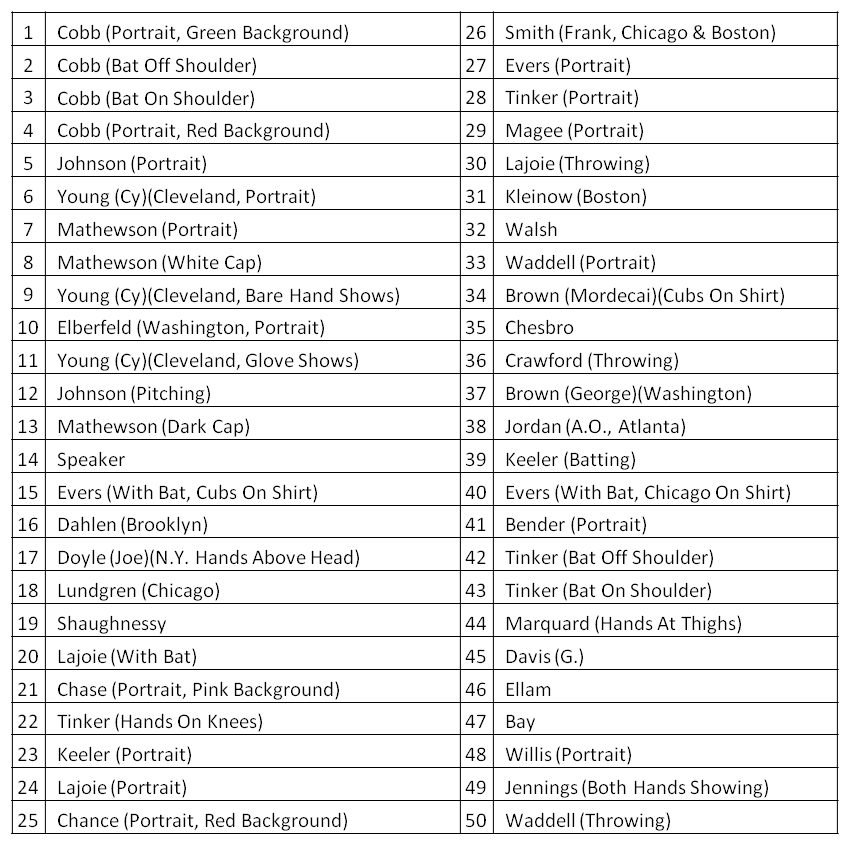 Once I had my "stars" I found the average prices in each grade (2-7) for PSA and SGC. 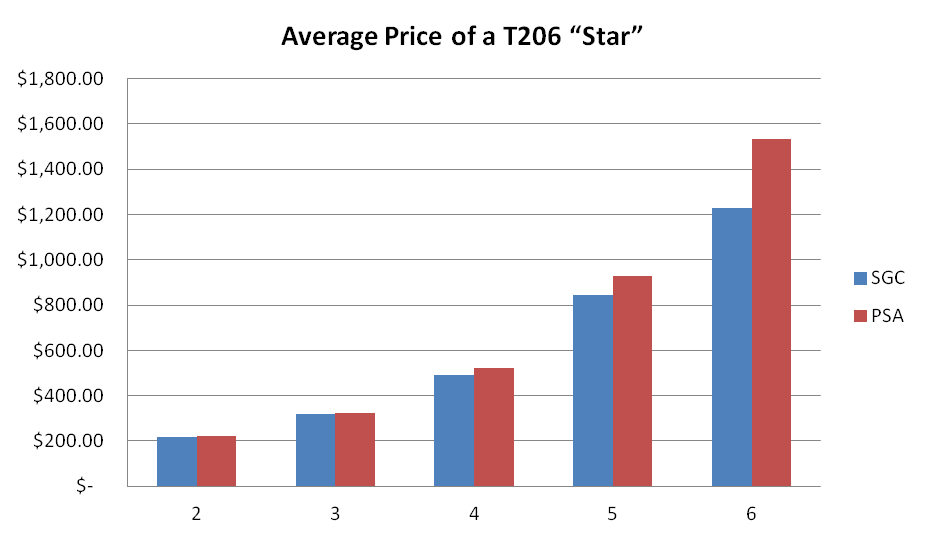 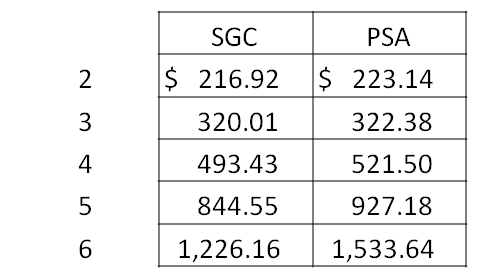 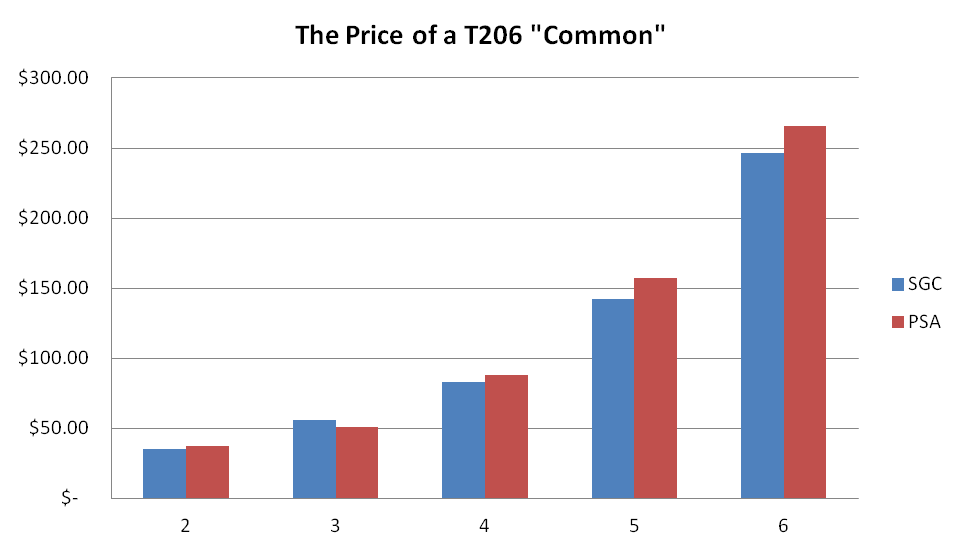 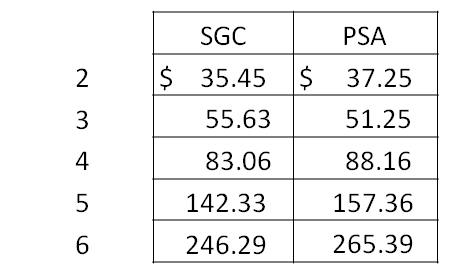 The results were pretty surprising in two regards: SGC commons are virtually identical in price compared to their PSA counterparts and low grade SGC cards can run for a premium over PSA. Another observation (that may not surprise many) was that high grade PSA stars carry a premium over SGC. I think this is in large due to registry fanatics and those "investor" type collectors I talked about in my previous post. However, I am much more interested in the "commons". Why would SGC 3 "commons" demand a premium over PSA 3's? This is especially interesting because there is a huge concentration of SGC 3's on the market: (From my previous post)  It seems as though SGC 3's are readily available and seemingly "high pop", so why would it be the only condition to carry a premium over PSA? You would think that the condition that has the highest supply would command a lower price, but this has not been the case across the board! PSA 6's and 7's are far more readily available than SGC, but they can carry a HUGE premium. Why is it that the conditions with the highest populations carry a premium?? Well, I believe a premium is established to the TPG company with the more readily accessible commons. It caters to the set collectors in us all, and set collectors are the driving force in establishing a value for commons. Think about it, there are very few Shad Berry collectors (not to pick on Shad Berry), and if there are any Shad Berry collectors, I doubt that there would be enough of them to influence the average price of a Shad Berry card. The collectors who purchase these low grade commons are doing so to "tackle the monster." They're trying to build sets on a budget with decent eye appeal. But why SGC 3's?? Like I said in my previous post, SGC caters to the collector. Low grade tobacco cards look better in SGC holders. I know that this will be debated, but I believe the premium for SGC 3's is, in part, driven by the eye appeal of the case. This solely applies to low grade cards. The black background can really make a fugly card "pop". Personally, I prefer the look of high grade cards in PSA holders compared to SGC, but for low grade cards, SGC wins hands down. But why the premium? Well, set collectors love uniformity. Let's face it, we are obsessive people. While I know many of you have sets with a combination of SGC, PSA and raw cards, I know most of us prefer one TPG company or another. The reason PSA 6's carry a premium is because a collector can more easily assemble a mid grade set using PSA cards over SGC. SGC can carry a premium because it is just as easy to assemble a low grade set using SGC cards as it is with PSA. If I were to apply this to every pre-war set I guarantee we would see the same trends. Whichever TPG company has the more readily accessible commons will carry a premium. Essentially, the supply of the cards determines the demand and the demand then determines the price. Interesting stuff 
|
|
#19
|
|||
|
|||
|
Interesting stuff. I've heard that sgc leans on the VG grade. They assign the grade more then vgex. Maybe the premium you are seeing is from people paying more for nicer looking VG cards, or maybe because there's a guy out there buying an all sgc 40 set right now

|
|
#20
|
||||
|
||||
|
Loved the analysis. I go for SGC because of their puritanical grading. PSA is too lenient and sloppy in their grading. I will purchase PSA cards only to crack them out and send to SGC for a true grading.
|
|
#21
|
||||
|
||||
|
Nice work. How about a comparison of the truly "elite star"cards versus the rest of the star cards? Lets say Cobb, Young, Johnson, and Mathewson vs the rest of the "star" cards. My guess here is that the elite "star" cards would favor PSA and that collectors would be more willing to chose between PSA and SGC with the other star cards. It could also account for a different type of collector. The T206 collector vs the collector who wants lets say a Cobb card for their collection. I think it would be interesting to see how the numbers align with perceptions.
Thanks again for all the work and an interesting thread. 
|
|
#22
|
|||
|
|||
|
I think this analysis is spot-on. I would just add that the trend toward PSA collectors at the higher end of the grading spectrum and SGC collectors at the lower end of the grading spectrum is self-reinforcing since supply begets more supply. Guys who collect the set in PSA 5 buy EX-looking raw commons and send them to PSA for slabbing and adding to their sets. On the other hand, guys who collect the set in SGC 3 buy VG-looking raw commons and send them to SGC for slabbing and adding to their sets. Hence ever-increasing supply of PSA 5s relative to SGC 5s and ever-increasing supply of SGC 3s relative to PSA 3s should drive more and more T206 EX collectors to PSA and more and more T206 VG collectors to SGC.
Last edited by sreader3; 02-20-2013 at 03:03 PM. |
 |
| Thread Tools | |
| Display Modes | |
|
|